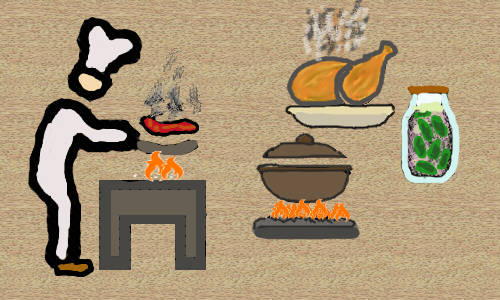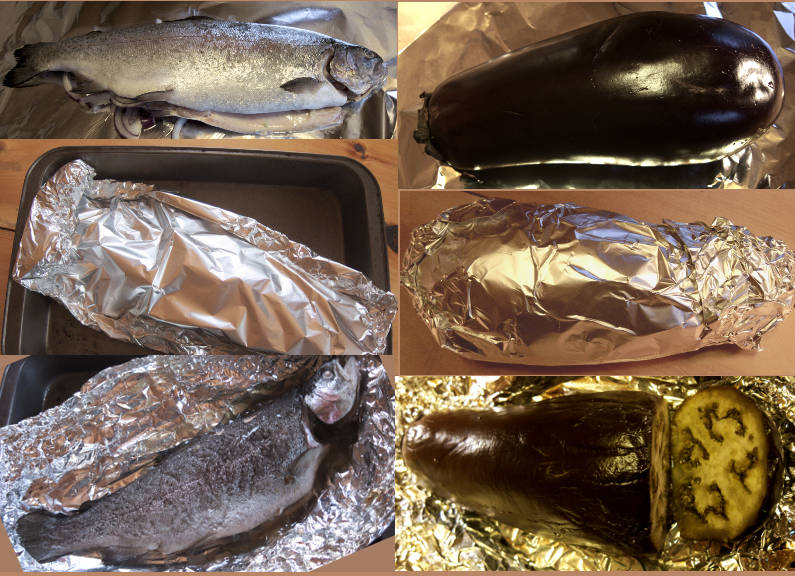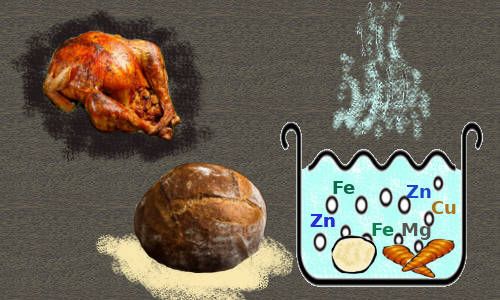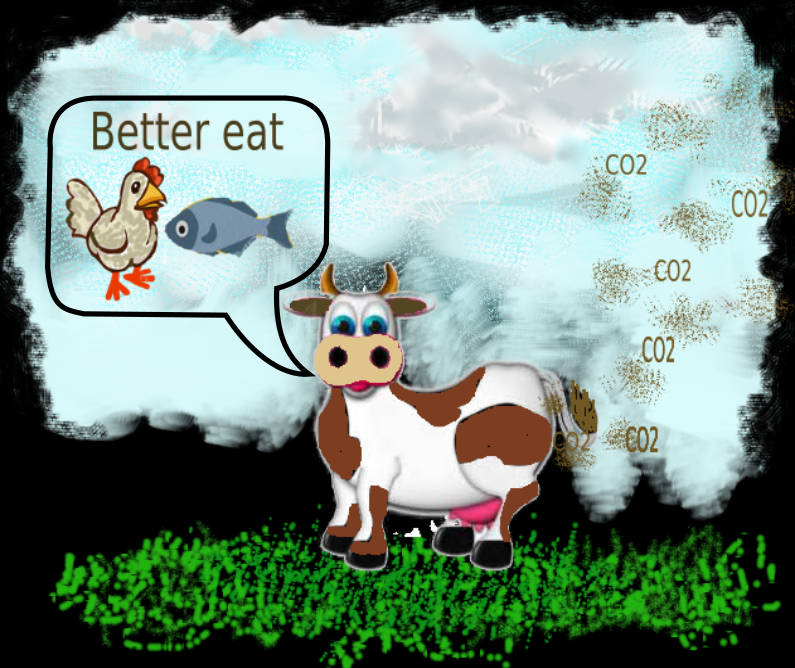NutriScience for everybody
Influences of food processing and preparation on the nutritional qualities

Food processing, preparation and cooking influence the nutritional qualities of foods and these processes can have advantages and disadvantages. The preparation and preservation of foods involve a great number of different processes, most of which have an effect, not always deleterious, on nutritional value[6]. Heat, one of the most used techniques for preparing food, although it usually causes some destruction of vitamins and protein, under certain conditions heat can maintain nutritive value by inactivating enzymes that would other-wise cause damage[6]. Thermal treatment of foods induces several biological, physical and chemical modifications, leading to sensory, nutritional and textural changes[5]. Cooking is also involved in the formation of desired compounds such as flavour compounds, antioxidants and colouring agents. On the other hand, processing can damage food quality, leading to undesired consequences, such as losses of certain nutrients due to chemical reactions, formation of undesired compounds such as acrylamide or molecules with negative effect on flavour perception, loss of texture, and discolouration[5]. For example food cooking has beneficial effects when is improving the digestibility and bioavailability of nutrients, and by enhancing attractiveness to the consumer because of improved texture and taste, and also eliminating deleterious effects due to loss of nutrients or the formation of toxic compounds [3], inactivating heat-labile antinutritional substances as in cassava or in some legumes, killing microbiological pathogens, making edible some foods such as rice, potatoes, or legumes, or by cooking and preservation techniques making year-round the availability of seasonal foods. Between the disadvantages we can mention the decrease, inactivation or destruction by heat of some nutrients such as vitamin C, vitamin B1 (thiamine), vitamin A and another micronutrients; also some nutrients may be lost in the water when they are boiled such as folate, vitamin B1 (thiamine), minerals and phytochemicals that are phytomoles considered as ‘non-nutrient.constituents of food plants with anticipated health promoting/beneficial and/or toxic effects when ingested[5].
Recent studies have shown there are several ways to enhance the availability of healthy nutrients through proper selection of the method of cooking. According to these studies, the most common methods used for cooking legumes and vegetables are: steaming, roasting, boiling, frying, sautéing, sous vide, microwave and pressure-cooking.[1]. The effect of food processing on nutrient content will depend on the sensitivity of the nutrient to the various conditions prevailing during the process, such as heat, oxygen, pH and light[4]. The storage conditions and handling after processing are also important to the nutritive value of the food[4].
Steaming was the cooking technique that has shown to be the best method for cooking vegetables because it has less impact on the bioavaibility of the micronutrients and the phytochemicals compounds. Ordinary heating or boiling of vegetables using water is likely to result in the elution of a high percentage of vitamins and minerals in the vegetables and these nutrients are decreased in ready-to-eat foods compared with traditional foods, while water-free cooking minimizes the elution of nutrients enabling efficient intake of vegetable nutrients [2].
Also, domestic preparations of vegetables and legumes that normally involve washing, peeling and cutting are anothers sources of cooking techniques that have influences on the nutritional properties of food. During food preparation when is used as chopping and trimming, chopping vegetables can alter the bioavailability of bioactive compounds such as carotenoids, polyphenols and flavonoids. Also it is well known that in onions and garlic, when the cells are damaged by chopping or crushing, the enzyme allinase is released and comes in contact with sulfur compounds increasing the pungency and the flavor of onions or converting in garlic the alliin, an odorless compound, to allicin, the bioactive compound responsible for the characteristic odor and flavor of fresh garlic [1][7].
So, at the moment to prepare our food, it is important to think about what is the best cooking technique to use for getting food with better nutritional properties.
________
[1]Fabbri, Adriana D.T. and Crosby, Guy A. 2016. A review of the impact of preparation and cooking on the nutritional quality of vegetables and legumes. International Journal of Gastronomy and Food Science 3, 2–11
[2] Mori, Mari et al. 2012. Effects of cooking using multi-ply cookware on absortion of potassium and vitamins: a randomized double-blind placebo control study. International Journal of Food Sciences and Nutrition. 63(5): 530-536.
[3] Hoffman, Richard and Gerber Mariette. 2015. Food processing and the Mediterranean Diet. Nutrients, 7.
[4] Morris, Audrey et al. 2004. Effect of processing on nutrient content of food. Vol 37, Nro. 3
[5] Palermo, Mariantonella et al. 2014. The effect of cooking on the phytochemical content of vegetables. J Sci Food Agric; 94: 1057–1070
[6] Bender A. E. 1966. Nutritional effects of food processing. J. Fd Technol. 1, 251-289.
[7] Cantwell, Marita. 2000. Alliin in garlic. Perishables Handling Quartely Issue No. 102.
Dry-wrapped cooking
A new cooking technique

Dry-wrapped cooking is a new cooking method were foods are cooked using the water cotained inside them. The technique is simple and follows these steps:
Fishes and vegetables such as carrots, sweet potatoes, potatoes, different kind of squash, eggplants, beets, peppers and others are good candidates to be cooked using the dry-wrapped cooking method. All of these food contain in their body more 70 per cent of water.
With this method of cooking, foods are not exposed to the light and to the oxygen, and it do not occur elucion of micronutrients out of the food. Maintaining the temperature of cooking under 100℃ has less effects on the labile compounds to the heat.
Foods cooked whit dry-wrapped cooking have better aroma, texture and taste. Just cut slice or portions, season them and the food is ready to eat and enjoy.
How cooking methods affect foods

Steaming, roasting, boiling, frying, sautéing, sous vide, microwave and pressure-cooking are the most common cooking methods used at home. Different methods of cooking can influence on the chemical compositions of vegetables. Choosing the proper method of cooking we can enhance the availability and get less lost of healthy nutrients. Food preparation at home as final step of the chain has also great influence on quality determining parameters like sensory attributes and the content of vitamins and minerals. It can change them both in a positive and negative way[1]. Cooking induces many chemical and physical modifications in foods; among these the phytochemical content can change. Changes in phytochemicals upon cooking may result from two opposite phenomena: (1) thermal degradation, which reduces their concentration, and (2) a matrix softening effect, which increases the extractability of phytochemicals, resulting in a higher concentration with respect to the raw material[2]. Thermal treatment of foods induces several biological, physical and chemical modifications, leading to sensory, nutritional and textural changes. First of all, cooking increases food safety as a result of the destruction of microorganisms and the inactivation of anti-nutritional factors and a second beneficial effect of cooking is the enhancement of the digestibility of food and the bioavailability of nutrients[2]. Among the negative effect of the thermal treatments on food we can mention the formation of acrylamide by roasting, frying and baking, lost of nutrients in the water when boiling vegetables and the effect of cooking on the vitamin C content of all the vegetables as the heating time increases
_________
[1] Bernhardt, Simone and Schlich, Elmar. 2006. Impact of different cooking methods on food quality: Retention of lipophilic vitamins in fresh and frozen vegetales. Journal of Food Engeneering 77, 327-333.
[2] Palermo, Mariantonella et al. 2014. The effect of cooking on the phytochemical content of vegetales. J Sci Food Agric 94; 1057-1070.

The science in our kitchen
The better way for processing Garlic.
The use of garlic is widely used in the world for seasoning food and for its medicinal properties. It is well known that the use of garlic in our kitchen dates back thousands of years. Garlic can rightfully be called one of nature’s wonderful plants with healing power. It can inhibit and kill bacteria, fungi, lower (blood pressure, blood cholesterol and blood sugar), prevent blood clotting, and contains anti-tumor properties. It can also boost the immune system to fight off potential disease and maintain health. It has the ability to stimulate the lymphatic system which expedites the removal of waste products from the body. It is also considered an effective antioxidant to protect cells against free radical damage. It can help to prevent some forms of cancer, heart disease, strokes and viral infections.[6]. Garlic is also highly rich in vitamins (especially vitamin B complex and vitamin C), antioxidants, flavonoids, minerals (especially P, K and Se), being even considered a rich source of other non-volatile phytonutrients with important medicinal and therapeutic properties, from which a particular emphasis is given to flavonoids, saponins and sapogenins, phenolic compounds, nitrogen oxides and amides and proteins[1]
Garlic flavor is due to the formation of organosulfur compounds when the main odorless precursor, alliin, is converted by the enzyme alliinase. This occurs at low rates unless the garlic cloves are crushed or damaged. The main compound formed by this reaction is a thiosulfinate, allicin, the compound responsible for the characteristic odor and flavor of fresh garlic. Allicin is considered the most important biologically active compound in garlic since it decomposes to other sulfur containing molecules (thiosulfonates and disulfides) which have purported activity in the human and model systems under investigation.[3]
When we are using garlic for seasoning our foods also we are thinking in the benefits in our health of the phytochemical compounds contained in garlic, mainly in the allicin. Usually in our kitchen we are using garlic in different ways for preparing our dishes thinking that we are getting all their benefits from garlic. Unfortunately not always we are getting in our foods all the benefits of garlic because we are not processing garlic in the right way due to domestic cooking practices may significantly decrease their contents in bioactive compounds and proteins, and consequently antioxidant activity, especially under prolonged exposure of our foods (>20 min) at 100 °C[1]. If we apply in our kitchen the knowledge of the science about garlic and its phytocompounds we can get better results and healthier foods.
Intact garlic cloves contain 0.24% by weight S-allylcysteine S-oxide (alliin), a colorless odorless solid, and an enzyme allinase which converts alliin into allicin[2] as well it has others bioactives phytocompounds such as anthocyanins, ascorbic acid, flavonoids, flavanols, polyphenols and tannins.
It was observed that allicin underwent nearly complete decomposition after 20 hr at 20°C. Upon injury of garlic cells, the enzyme alliinase comes in contact with alliin and produces allicin. Allicin is a very unstable compound which immediately degrades into the strong smelling constituents of garlic oil [2]. At 35 °C the maximum enzymatic conversion of alliin to allicin[4]. The outcome of the experiments shows that allicin is unstable at lower pH and more stable at pH 6.0 to 8.0. Allicin also shows an almost stable condition with slow decomposition rate within the temperature range of 30 °C to 35 °C. However, at 40 °C the compound starts to show gradual decomposition. [5]. In fresh-peeled garlic, the thiosulfinate (mostly alliin) content of the cloves decreased only 10-15% during 3 weeks storage at 5°C (41°F). Storage at 10°C (50°F), however, resulted in a much larger loss of alliin over the same period. Intact garlic bulbs lost about 25- 40% of their pungency after 4 months storage at 0- 1°C (32-33°F) in air, but in controlled atmospheres with 0.5% O2 alone or in combination with 5 or 10% CO2 maintained pungency levels.[3]. Typical garlic food preparation such as chopping, mincing and crushing disturbs S-allyl cysteine sulfoxide and expose it to the allinase enzymes, that quickly converted it to diallyl thiosulfinate, which give off garlic’s characteristic aroma[6]. Blanching, boiling, frying and microwaving, did not significantly affect the content in bioactive compounds (anthocyanins, ascorbic acid, flavonoids, flavanols, polyphenols and tannins) and antioxidant activities of garlic [1] while allicin decomposes at different rate in different temperature conditions and is susceptible to decompose faster at higher temperature. [5].
Recommendations
Always use fresh garlic and avoid storage.
Chopping, mincing and crushing with some water at 30-35 °C and preferable at pH 6 are the best processing techniques for getting the maximum quantity of allicin.
Flavor your food spreading over the raw or cooked meals the chopped, minced or crushed garlic in water.
__________
[1] Martins, Natália et al. Chemical composition and bioactive compounds of garlic (Allium sativum L.) as affected by pre- and post-harvest conditions: A review. University of Thessaly, School of Agricultural Sciences.
[2] Yu, Ting-Hsi and Wu, Chung. 1989. Stability of allicin in garlic juice. Journal of food Science, Vol. 54, Nro.4
[3] Cantwell, Marita. 2000. Perishables Handling Quartely Issue nro.102
[4]Mishra, Rashmi et al. 2001. Stability of allicin in garlic – A kinetic study. Indian Journal of Chemical Techonology Vol. 8, pp. 195-199
[5] Masonr, Nurlidia et al. 2016. Quantification and characterization of allicin in garlic extract. Journal of Medical and Bioengineering Vol. 5, No. 1
[6] Gebreyohannes, Gebreselema and Gebreyohannes, Mebrahtu. 2013. Medicinal values of garlic: A review. International Journal of Medicine and Medical Scienes. Vol. 5(9), pp. 401-208.
Garlic: Allium sativum
Nutritional Values
| Nutrients and Phytochemicals per 10 g of garlic | |||||||
| Nutrients | Phytochemicals (mg) | ||||||
| Macronutrients (g) | Vitamins | Minerals (mg) | |||||
| Water | 5.86 | Vit.C | 120 mg | Calcium | 18.1 | Kaempferol | 0.026 |
| Fiber | 0.21 | Thiamin | 0.02 mg | Iron | 0.17 | Myricetin | 0.161 |
| Carbohydrate | 3.31 | Riboflavin | 0.011 mg | Magnesium | 2.5 | Quercitin | 0.174 |
| Protein | 0.64 | Niacin | 0.07 mg | Phosphorus | 15.3 | Diagzein | 0.001 |
| Fat | 0.05 | Vit.B6 | 0.124 mg | Potasium | 40.1 | Genistein | 0.002 |
| Cholesterol | 0.00 | Folate DFE | 0.3 ug | Sodium | 1.7 | Total Isoflavones | 0.002 |
| Saturated Fat | 0.01 | Vit.A | 0.9 IU | Zinc | 0.12 | Biochanin A | 0.005 |
| Trans Fat | 0.00 | Vit.E | 0.08 mg | ||||
| MUFAs | 0.001 | Vit.K | 0.17 ug | ||||
| PUFAs | 2.80 | ||||||
| Omega-6 | 0.023 | ||||||
| Omega-3 | 0.002 | ||||||
Source: Nutrigenic Helper Databases.
Black and Green Teas Preparation

Recommended brewing methods for preparing black and green tea:
Black tea preparation:
Decoction: Let black tea bag or leaves boil for 5 minutes.
You will get fluoride concentration from[1]:
Bag tea: 0.14-0.25 mg of fluoride per each grams of black tea.
Leaves tea: 0.12-0.68 mg of fluoride per each grams of black tea.
Drink no more 4 cups per day.
Green tea preparation:
Method used by Chinese people for tea preparation: a tea bag is dipped in warm water having the temperature of 75-85 °C for 3 to 5 minutes[2].
Drink a any time.
[1] Zerabruk, Samuel et al. 2010. Fluoride in black and green tea (camellia sinensis) infusions in ethiopia: measurement and safety evaluation. Bull. Chem. Soc. Ethiop. 2010, 24(3), 327-338.
[2] Safdar, Naila et al. 2016. Ten different brewing methods of green tea: comparative antioxidant
study. Journal of Applied Biology & Biotechnology Vol. 4 (03), pp. 033-040.
eidos-project.net © 2016- 2025